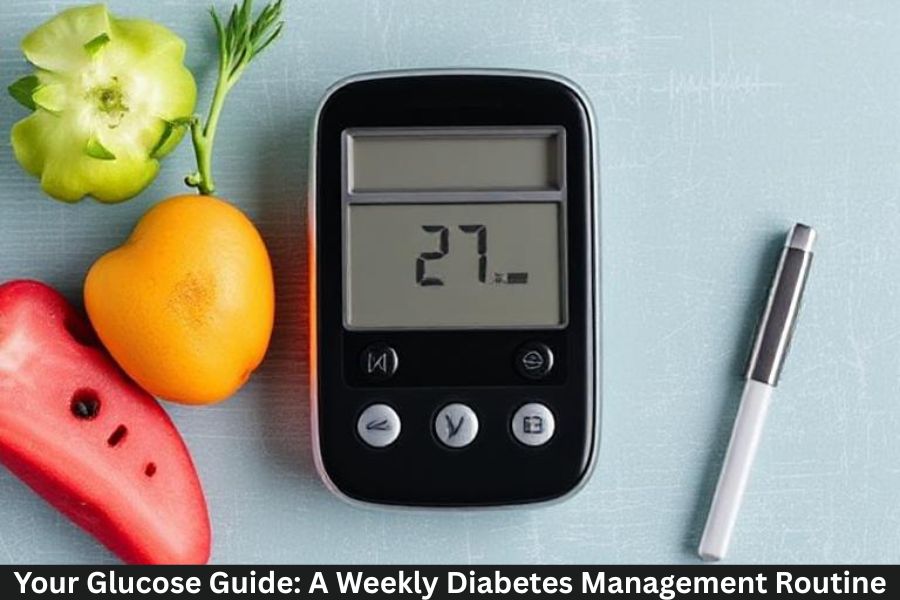Diabetes management stacks many tiny decisions. A weekly template zips those choices into predictable habits: same review day, same prep day, same check-ins. You free your brain from constant decision fatigue and catch patterns earlier—before they snowball.
Know Your Tools: Glucose Meter vs. CGM
Finger-Stick Glucose Meter
- Pros: Affordable, reliable when used correctly.
- Watch-outs: Clean hands (no fruit residue), use fresh strips, log context (meal, exercise, stress).
Continuous Glucose Monitor (CGM)
- Pros: Trends, alerts, “time in range,” less finger-stick hassle.
- Watch-outs: Occasional sensor lag vs. blood glucose, compression lows during sleep, calibrate per instructions if your model supports it.
Set Personal Targets (With Your Care Team)
Typical care plans include fasting, pre-meal, and post-meal targets plus a long-term A1C goal. These aren’t one-size-fits-all—they vary by age, pregnancy, comorbidities, and medications. Ask your clinician:
- What are my pre- and post-meal targets?
- How often should I check?
- When should I call you (e.g., persistent highs/lows, sick days, new meds)?
Your 7-Day Diabetes Rhythm
Monday — Baseline & Plan
- Morning: Capture fasting and pre-breakfast reading.
- Midday: One post-meal check (2 hours after).
- Evening: Pre-dinner reading.
- Plan: Block 2–3 workouts on your calendar, schedule grocery delivery or a store run, and pick three easy dinners.
Tuesday — Nail Meal Timing & Carb Quality
- Eat at consistent times to simplify pattern spotting.
- Try fiber-first: salad or non-starchy veg before starch.
- Anchor carbs with protein + healthy fat (e.g., eggs + avocado with toast; lentils + yogurt; tofu stir-fry with nuts).
Wednesday — Movement Consistency
- Do 30–45 minutes of activity (walks count!).
- If you lift weights, expect different glucose responses (sometimes a short-term rise); track how your body reacts.
- Check pre- and post-exercise as advised by your clinician, especially if you use insulin or sulfonylureas.
Thursday — Pattern Review & Micro-Tweaks
- Scan your readings since Monday.
- Identify repeat spikes (same meal? portion size? timing?).
- Make one small change (e.g., add veg starter, reduce rice by ¼ cup, take a 10-minute walk after lunch).
Friday — Sleep & Stress Check
- Poor sleep and stress can push numbers up.
- Tonight, aim for a consistent bedtime, cool/dark room, and screens off 30–60 minutes before bed.
- Add 5 minutes of breathwork or a quiet stretch.
Saturday — Grocery + Prep Day
- Shop from a glucose-friendly list (see below).
- Batch cook: a pot of beans or lentils, roast a sheet pan of veggies, grill or bake proteins, cook a whole-grain base.
- Pre-portion snacks to prevent “hangry raids.”
Sunday — Big Picture Review & Reset
- Review time-in-range (if using CGM) or your log.
- Celebrate a win (fewer spikes after breakfast? more steps?).
- Set one focus for next week (e.g., night snacking, hydration, consistent pre-bed check).
- Refill meds, sensors, lancets; pack a small low kit (fast-acting carbs) for your bag.
Daily Checklist (5-Minute Routine)
- Morning: Fasting reading; meds as prescribed; water first, then breakfast.
- Pre-meal: Check or glance at CGM trend; decide on portion/protein.
- Post-meal (2 hr): Spot-check 1–2 meals/day on rotation.
- Movement: 10–20-minute walk after your largest carb meal.
- Evening: Pre-bed reading; lay out meds/supplies for tomorrow.
Meals That Play Nice With Glucose
Build Your Plate
- ½ plate: Non-starchy veggies (greens, broccoli, peppers, mushrooms).
- ¼ plate: Protein (fish, chicken, tofu, paneer, eggs, legumes).
- ¼ plate: Smart carbs (beans, lentils, quinoa, brown rice, yogurt, fruit).
Smart Swaps
- White rice → brown rice or cauli+rice mix
- Sugary cereal → Greek yogurt + nuts + berries
- Fries → roasted sweet potato wedges
- Soda/juice → water, sparkling water, or unsweetened tea
Snack Ideas
- Apple + peanut butter
- Handful of nuts + cheese or paneer cubes
- Hummus + veggie sticks
- Greek yogurt with chia
Exercise & Glucose: What to Expect
- Aerobic (walking, cycling, swimming): Often lowers glucose during/after.
- Resistance (weights, bands): Builds muscle (great for insulin sensitivity). Short-term bumps can happen—look at the 24-hour trend.
- High-intensity: Can raise glucose transiently (adrenaline) then settle later.
If you’re at risk for lows: Carry fast-acting carbs, wear identification, and follow your clinician’s guidance on pre-exercise readings and medication timing.
Medication Adherence Without the Headache
- Habit stack: Take meds with a daily anchor (e.g., after brushing teeth).
- Reminders: Phone alarms, pill organizers, smart caps.
- Travel/time zones: Ask your clinician for a time-shift plan; pack double supplies in separate bags.
- New meds? Track how your readings and digestion feel for the first 2–4 weeks.
Stress, Hormones, and Sleep: The Hidden Glucose Drivers
- Stress hormones can push glucose up—even with perfect meals.
- Daily micro-stress relief (walks, journaling, breathwork) adds up.
- Sleep: Aim for a steady schedule; caffeine after mid-afternoon can hurt sleep quality (and tomorrow’s numbers).
Sick-Day Basics (Have a Plan Before You Need It)
Illness can raise glucose and increase dehydration risk. Ask your clinician for a sick-day plan that covers:
- How often to check glucose/ketones
- Which meds to pause or adjust
- Which fluids and carbs to use if you can’t eat normally
- Red flags that mean urgent care (persistent vomiting, high ketones, confusion, severe dehydration)
Tape the plan inside a kitchen cabinet for quick access.
Foot, Eye, and Dental Care—The Overlooked Trio
- Daily foot check: Cuts, blisters, redness, or swelling → address early.
- Annual eye exam: Or more frequently as advised.
- Dental cleanings: Gum health and glucose control are linked.
- Shoes/socks: Breathable, seamless; break in gradually.
Data Without Drama: How to Read Your Trends
If You Use a Meter
- Compare like with like: pre-meal vs. pre-meal, 2-hour post-meal vs. 2-hour post-meal.
- Circle 1–2 problem meals and test small tweaks (portion, fiber, walk).
If You Use CGM
- Look at time in range and glycemic variability.
- Find repeat patterns (mornings high? late-night climbs?).
- Write a one-line summary each Sunday: “Breakfast spikes reduced when I added yogurt and berries.”
Safety First: Hypo & Hyper—Know the Signs
- Hypo (low): Shaky, sweaty, hungry, irritable, dizzy, fast heartbeat.
- Follow your provider’s fast-acting carb protocol; recheck as directed.
- Hyper (high): Thirst, frequent urination, fatigue, blurred vision, headache.
- Hydrate, walk gently if safe, follow your plan; contact your clinician for persistent highs.
Post a simple action card on your fridge and screenshot it for your phone.
Dining Out, Parties, and Travel—Real Life Included
- Scan the menu before you go; plan your anchor (protein + veg).
- Ask for swaps: Extra veg instead of fries, dressing on the side.
- Pace desserts: Split, or pair with protein; enjoy mindfully.
- Travel kit: Meter/CGM supplies, snacks, low treatment, a water bottle, and a brief note on your condition.
Build Your Personal Glucose Playbook
Create a one-page sheet (phone note works) with:
- Your targets and when to check
- Go-to breakfasts, lunches, dinners, snacks
- Movement menu: 10-, 20-, and 40-minute options
- Hypo/Hyper steps from your clinician
- Weekly rhythm (Mon baseline, Thu review, Sat prep, Sun reset)
When life gets busy, your playbook brings you back to center.
Conclusion
Diabetes management becomes easier when your week has a predictable flow. A few strategic anchors—meal timing, movement, sleep, stress care, and a Sunday reset—turn daily glucose from guesswork into guided choices. Stay curious about your patterns, make one small improvement at a time, and keep your care team in the loop. Progress loves consistency.
FAQs
1) How often should I check my glucose?
It depends on your treatment plan (diet-controlled, oral meds, insulin, CGM). Ask your clinician for a schedule that fits your life and safety.
2) What’s one change that usually helps quickly?
A 10-minute walk after your largest carb meal. It’s simple, sustainable, and often flattens post-meal spikes.
3) Do I need a CGM to manage well?
Not necessarily. Many people succeed with a meter plus consistent logging. CGMs provide trends and alerts—great if they fit your plan and budget.
4) Are carbs “bad” for diabetes?
Carbs aren’t the villain—quality, portion, and timing matter. Pair carbs with fiber + protein + healthy fat to smooth the curve.
5) What should I track besides glucose?
Sleep hours, steps/movement, meals, stress level, meds. These clues explain your numbers and point to easy wins.




https://shorturl.fm/nXmDE
https://shorturl.fm/RATD7